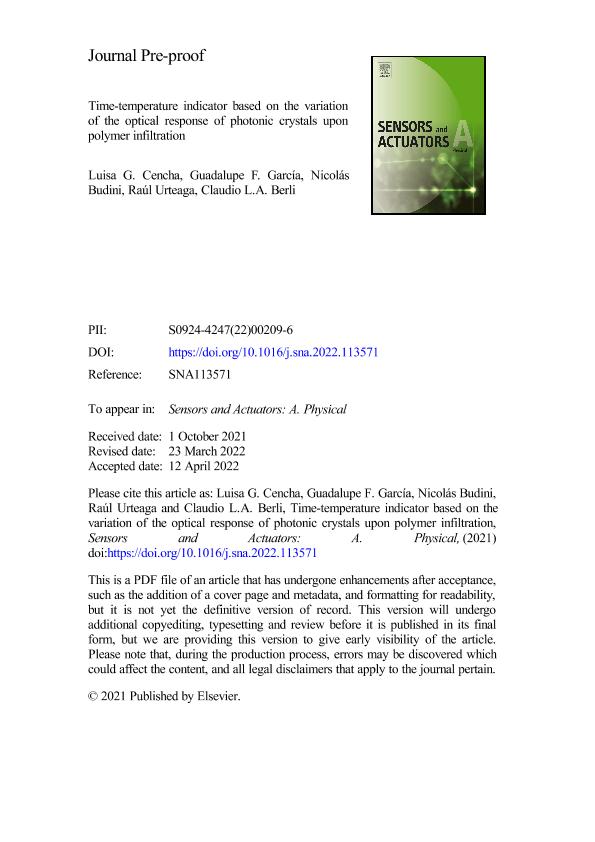Artículo
Time-temperature indicator based on the variation of the optical response of photonic crystals upon polymer infiltration
Cencha, Luisa Guadalupe ; García, Guadalupe F.; Budini, Nicolas
; García, Guadalupe F.; Budini, Nicolas ; Urteaga, Raul
; Urteaga, Raul ; Berli, Claudio Luis Alberto
; Berli, Claudio Luis Alberto
 ; García, Guadalupe F.; Budini, Nicolas
; García, Guadalupe F.; Budini, Nicolas ; Urteaga, Raul
; Urteaga, Raul ; Berli, Claudio Luis Alberto
; Berli, Claudio Luis Alberto
Fecha de publicación:
07/2022
Editorial:
Elsevier Science SA
Revista:
Sensors and Actuators A: Physical
ISSN:
0924-4247
Idioma:
Inglés
Tipo de recurso:
Artículo publicado
Clasificación temática:
Resumen
Time-temperature indicators are used for sensing the thermal history of perishable products, like food and pharmaceutical goods. Their working principle is based on a temperature response that mimics the temperature dependence of the deterioration kinetics of a given product. For successful implementation, time-temperature indicators must be of minimum size, cost-effective, change-irreversible, and easy to read. This work presents a time-temperature sensor based on capillary imbibition of thermoplastic polymers into a mesoporous photonic crystal, which was tuned to reflect well-defined wavelengths of visible light. The photonic crystal was made by electrochemical etching of silicon, where a periodic structure was formed with microscale layers of alternating nanoscale porosity. Polymer infiltration induces an irreversible change of the effective refractive index of the crystal, leading to a progressive shift of the reflected light that can be seen by the naked eye. Importantly, the employed thermoplastic polymer (poly(ethylene vinyl-acetate)) presents a temperature-dependent viscosity that is well represented by the Arrhenius law, which is normally used to characterize the temperature-dependence of quality indexes. Therefore, each reflected color is associated to the time-temperature history of the system, representing the deterioration level of a monitored product.
Archivos asociados
Licencia
Identificadores
Colecciones
Articulos(INTEC)
Articulos de INST.DE DES.TECNOL.PARA LA IND.QUIMICA (I)
Articulos de INST.DE DES.TECNOL.PARA LA IND.QUIMICA (I)
Citación
Cencha, Luisa Guadalupe; García, Guadalupe F.; Budini, Nicolas; Urteaga, Raul; Berli, Claudio Luis Alberto; Time-temperature indicator based on the variation of the optical response of photonic crystals upon polymer infiltration; Elsevier Science SA; Sensors and Actuators A: Physical; 341; 7-2022; 1-21
Compartir
Altmétricas



